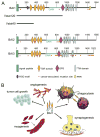Adhesion GPCRs in Tumorigenesis
- PMID: 27832497
- PMCID: PMC5389670
- DOI: 10.1007/978-3-319-41523-9_17
Adhesion GPCRs in Tumorigenesis
Abstract
Alterations in the homeostasis of several adhesion GPCRs (aGPCRs) have been observed in cancer. The main cellular functions regulated by aGPCRs are cell adhesion, migration, polarity, and guidance, which are all highly relevant to tumor cell biology. Expression of aGPCRs can be induced, increased, decreased, or silenced in the tumor or in stromal cells of the tumor microenvironment, including fibroblasts and endothelial and/or immune cells. For example, ADGRE5 (CD97) and ADGRG1 (GPR56) show increased expression in many cancers, and initial functional studies suggest that both are relevant for tumor cell migration and invasion. aGPCRs can also impact the regulation of angiogenesis by releasing soluble fragments following the cleavage of their extracellular domain (ECD) at the conserved GPCR-proteolytic site (GPS) or other more distal cleavage sites as typical for the ADGRB (BAI) family. Interrogation of in silico cancer databases suggests alterations in other aGPCR members and provides the impetus for further exploration of their potential role in cancer. Integration of knowledge on the expression, regulation, and function of aGPCRs in tumorigenesis is currently spurring the first preclinical studies to examine the potential of aGPCR or the related pathways as therapeutic targets.
Keywords: Metastasis; Tumor angiogenesis; Tumor cell migration; Tumor invasion; Tumor therapy.
Figures

Similar articles
-
7TM Domain Structure of Adhesion GPCRs.Handb Exp Pharmacol. 2016;234:43-66. doi: 10.1007/978-3-319-41523-9_3. Handb Exp Pharmacol. 2016. PMID: 27832483 Review.
-
Control of Adhesion GPCR Function Through Proteolytic Processing.Handb Exp Pharmacol. 2016;234:83-109. doi: 10.1007/978-3-319-41523-9_5. Handb Exp Pharmacol. 2016. PMID: 27832485 Review.
-
Classification, Nomenclature, and Structural Aspects of Adhesion GPCRs.Handb Exp Pharmacol. 2016;234:15-41. doi: 10.1007/978-3-319-41523-9_2. Handb Exp Pharmacol. 2016. PMID: 27832482 Review.
-
To Detach, Migrate, Adhere, and Metastasize: CD97/ADGRE5 in Cancer.Cells. 2022 May 4;11(9):1538. doi: 10.3390/cells11091538. Cells. 2022. PMID: 35563846 Free PMC article. Review.
-
Adhesion GPCRs as Modulators of Immune Cell Function.Handb Exp Pharmacol. 2016;234:329-350. doi: 10.1007/978-3-319-41523-9_15. Handb Exp Pharmacol. 2016. PMID: 27832495 Review.
Cited by
-
Spatial regulation of GPR64/ADGRG2 signaling by β-arrestins and GPCR kinases.Ann N Y Acad Sci. 2019 Nov;1456(1):26-43. doi: 10.1111/nyas.14227. Epub 2019 Sep 9. Ann N Y Acad Sci. 2019. PMID: 31502283 Free PMC article.
-
The tethered peptide activation mechanism of adhesion GPCRs.Nature. 2022 Apr;604(7907):757-762. doi: 10.1038/s41586-022-04575-7. Epub 2022 Apr 13. Nature. 2022. PMID: 35418682 Free PMC article.
-
Surface marker profiling of SH-SY5Y cells enables small molecule screens identifying BMP4 as a modulator of neuroblastoma differentiation.Sci Rep. 2017 Oct 19;7(1):13612. doi: 10.1038/s41598-017-13497-8. Sci Rep. 2017. PMID: 29051534 Free PMC article.
-
Gedunin- and Khivorin-Derivatives Are Small-Molecule Partial Agonists for Adhesion G Protein-Coupled Receptors GPR56/ADGRG1 and GPR114/ADGRG5.Mol Pharmacol. 2018 May;93(5):477-488. doi: 10.1124/mol.117.111476. Epub 2018 Feb 23. Mol Pharmacol. 2018. PMID: 29476042 Free PMC article.
-
On-target and off-target effects of novel orthosteric and allosteric activators of GPR84.Sci Rep. 2019 Feb 12;9(1):1861. doi: 10.1038/s41598-019-38539-1. Sci Rep. 2019. PMID: 30755705 Free PMC article.
References
-
- Krishnan A, Nijmeijer S, de Graaf C, Schiöth HB. Classification, nomenclature and structural aspects of adhesion GPCRs. In: Langenhan T, Schöneberg T, editors. Adhesion G protein-coupled receptors: molecular, physiological and pharmacological principles in health and disease. Springer; Heidelberg: 2016.
-
- Kovacs P, Schöneberg T. The relevance of genomic signatures at adhesion GPCR loci in humans. In: Langenhan T, Schöneberg T, editors. Adhesion G protein-coupled receptors: molecular, physiological and pharmacological principles in health and disease. Springer; Heidelberg: 2016. - PubMed
-
- Araç D, Sträter N, Seiradake E. Understanding the structural basis of adhesion GPCR functions. In: Langenhan T, Schöneberg T, editors. Adhesion G protein-coupled receptors: molecular, physiological and pharmacological principles in health and disease. Springer; Heidelberg: 2016. - PubMed
-
- Nijmeijer S, Wolf S, Ernst OP, de Graaf C. 7TM domain structure of adhesion GPCRs. In: Langenhan T, Schöneberg T, editors. Adhesion G protein-coupled receptors: molecular, physiological and pharmacological principles in health and disease. Springer; Heidelberg: 2016.
-
- Nieberler M, Kittel RJ, Petrenko AG, Lin H-H, Langenhan T. Control of adhesion GPCR function through proteolytic processing. In: Langenhan T, Schöneberg T, editors. Adhesion G protein-coupled receptors: molecular, physiological and pharmacological principles in health and disease. Springer; Heidelberg: 2016.
Publication types
MeSH terms
Substances
Grants and funding
LinkOut - more resources
Full Text Sources
Other Literature Sources
Miscellaneous

